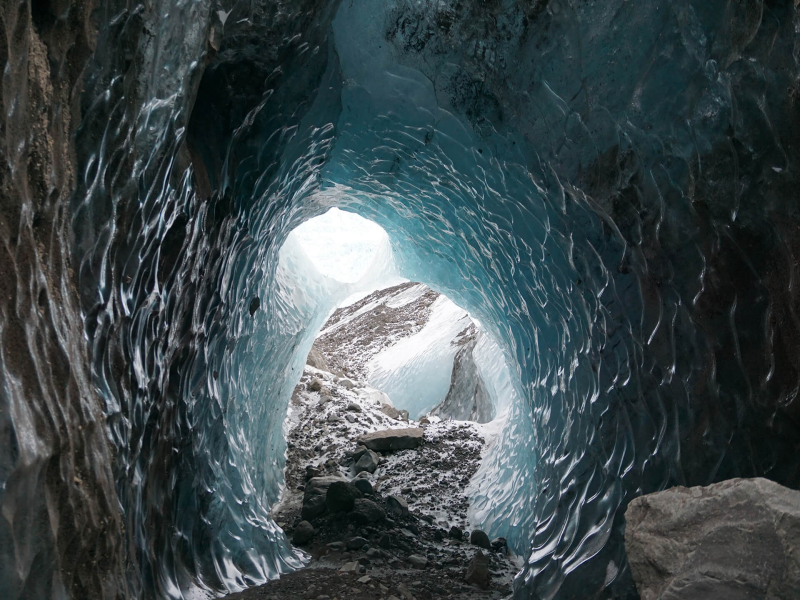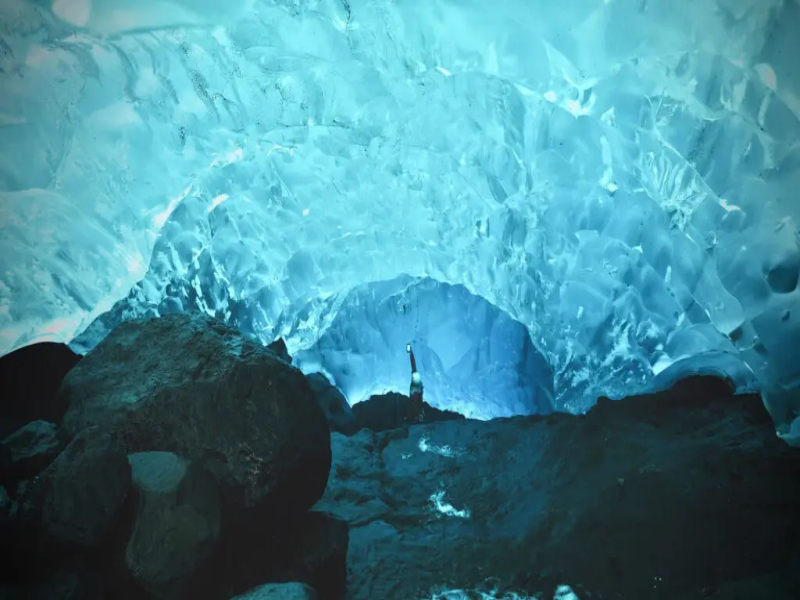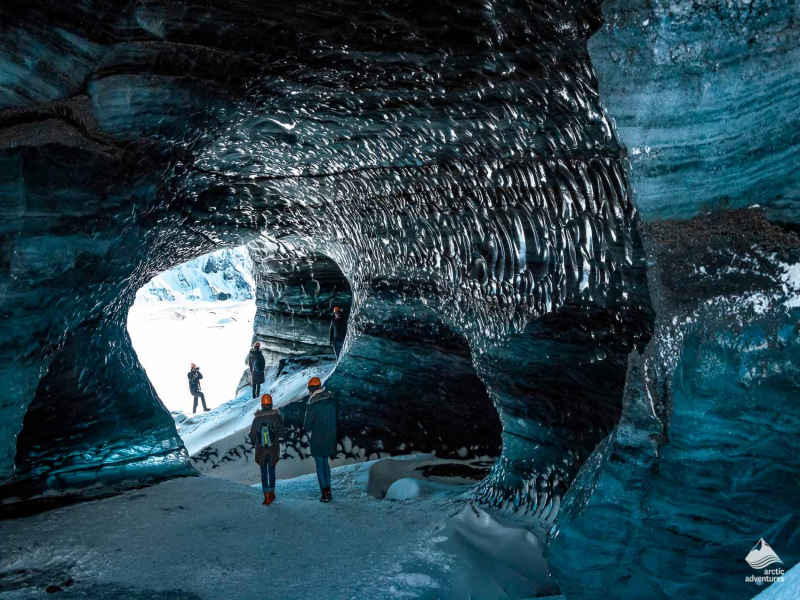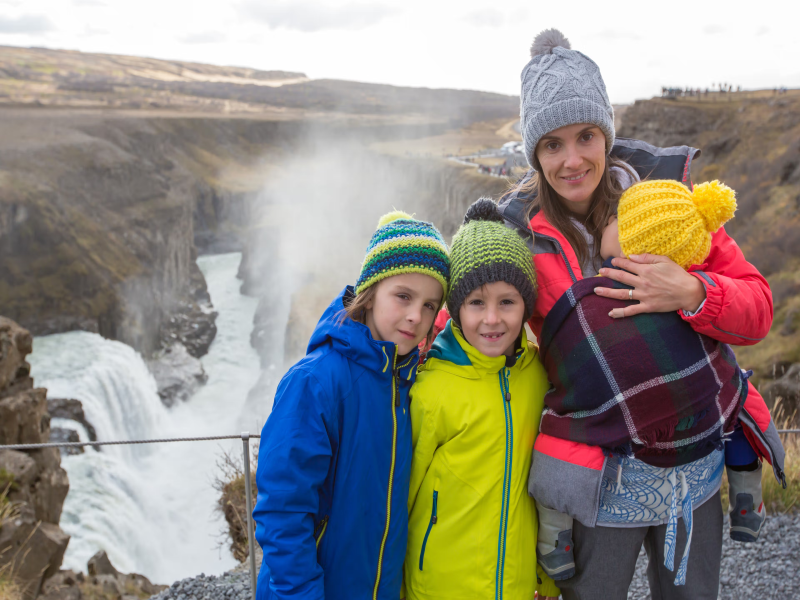Introduction
Just picture yourself surrounded by a realm of stunning blue ice that has patterns similar to the diamonds and only sound heard is the dripping of the ice melting. This is the magic of ice caving in Vatnajökull, world’s fifth largest glacier located in Iceland. So these places become very distinctive being able to consumes the center of the glacier itself and also see the stunning sand.
This ultimate travel guide will provide you with informational background about Vatnajökull ice caves from how they are formed to how you can get there too. Some of the boring basics we’ll discuss will include safety measures, accessibility, and what one can anticipate when entering this arctic space.

What is Vatnajökull?
Vatnajökull is not just any glacier, Vatnajökull is a giant glacier which can be proud of itself being the largest glacier in Europe. The biggest one is in the southeastern part of Iceland and occupies about 8 percent of the island’s territory. That is a large caldera, which occupies several volcanoes and is located right in the Arctic Circle, includes the erupting Grímsvötn.
It was formed thousands of years ago when snow accumulate on the site and turn into this massive ice cap. Glacial landscape is a dynamic system as the area is in constant process of changing as influenced by natural factors.
Did you know? Because it is very extend that it has other glaciers which are outlet glaciers of Vatnajökull and they all have different features and different ice caves. Three of the most sought after ice caves for tourists are the Breiðamerkurjökull, Skaftafellsjökull and last but not the least the Svínafellsjökull.
What are Ice Caves?
Ice caves are freeness or pit formed by glaciers or ice and they are temporal forms of geographical structures. They are not the natural caves produced in rock as the familiar concept of caving defines them but they are the constructions of the active processes of material and energy users: ice, water, and air.
How are they formed?
- Meltwater: In course of warmer months, or, relatively, when they are raining, meltwater flows make their way through water conduits in the glacier. These rivers of water flow across the ice like artists carving to carve out pathways on it here.
- Glacial Movement: In its course, it slowly moves down slopes with crevasses and cracks in between. Water can also melt in in these cracks and find its way further into the openings making the ice cave larger.
- Air Circulation: This is also true because gaps or pockets of air within the glacier can partly do the work of a cavity in forming ice cave. Warm air, which finds its way into the zones, secretes cavities and melts the separate ice.
Types of Ice Caves
- Subglacial Ice Caves: These caves are found at the bottom of glacier, the are usually formed by the water eroding its way through ice at the base of the glacier. Typically it continues a rocky floor and can include large ice structures falling from the roof.
- Englacial Ice Caves: These are actual ice caves, incased in the glacier and sometimes, formed in or by ice melt water streams. They are identified by slender, molded walls, and a sparkling blue sheen.
- Supraglacial Ice Caves: These are upper caves developed on the glacier and are usually caused by melting water and air movements. They often are smaller and less stable than other classes of ice caves.
Glaciers are constantly undergoing gradual changes; therefore, ice caves are unique structures that are installing in nature. They are dynamic and may extend over a short time, or the existing cave may be closed off, or even change their form. It is perhaps due to this contingency that contributes to their charm and whereby every time you arrive something different will face you.
Why Ice Cave in Vatnajökull?
Ice caves are present in numerous countries with various glaciers but what makes the ice caves of Vatnajökull unique. Here’s why:
- Unparalleled Beauty: Vatnajökull has ice caves but particularly, the caves contain blue ice. This bright coloration is due to the fact that this ice is under high pressure and the higher-pressure ice lenses preferentially scatters only the longer blue wavelengths of light.
- Mesmerizing Formations: Check out a wide variety of outstanding ice formations, works of art, icicles, and frozen waterfalls which have been created by nature. Each turn has a new discovery, thus; every ice cave can be considered as a brand-new experience.
- Accessibility and Variety: Vatnajökull Glacier provides a variety of options for each passenger or group regarding the kind of ice caves and adventure. There’s always a tour that will satisfy clients who wish to take up a challenging hike or those who prefer more relaxed journey to the park.
- A Photographer’s Paradise: Inasmuch as Vatnajökull contains ice caves, the angles of light and reflection on the ice make it a photographer’s paradise. It is crucial to take amazing photos of the blue ice, complexities of the formations, the airspace of these worlds of ice.
Aside from the aesthetic aspect, what is more, exciting is that it can make you feel the realness of the beauty of nature. This will occur due to its enormous potential for presenting the viewer with pure force of glacial activity in addition to allowing the audience to better comprehend the fragility of our planet’s ecosystem.
When is the Best Time to Go Ice Caving in Vatnajökull?
The point can be made that the overall beauty of Vatnajökull ice caves largely depends on the time chosen. Such wonders are best viewed during a particular time of the year and thus the duration of the trip must be well coordinated.
Winter season, (December – February/ March).
Ice caves in Vatnajökull are best visited during winter and the most favored season to properly explore the ice caves begins in November and lasts until March. Here’s why:
- Safety First: The ice caves, so to speak, can only be approached in wintertime because the chilly weather then freezes the ice hard enough to support explorers. Specially during the warmer months the melting and the changing of the ice become a potential cause of danger.
- Optimal Ice Formations: Winter offers the best season in that it guarantees that there is ice within the cave formations at their most impressive. You may see, for example, very delicate fragile carving – icy lace, glittering ice supports, stunning crystal shapes and patterns.
- Lighting and Photography: At this time of year, low sunshine makes grottoes extremely mystical both outside and within the ice caves. This guarantees soft diffused light that brings out the blues and set the best environment for excellent photographs.
Important Note: First, it is ever important to note that in despite of the fact that it is winter, the weather, as generally known, can be unpredictable especially in Iceland. It is always a good idea to consider the weather and plan accordingly, or to cancel a tour because of a threatened storm.
Planning Your Trip:
- Peak Season: The most significant amount of tourists in ice caves appears to visit it in December and February. If you want to avoid many other tourists, it’s better to visit this place in November or in March.
- Flexibility: Try to be a little more lenient with the dates you’d like to undertake the tour due to weather conditions. Scheduling flexibility can be extremely helpful because it is far easier to do something when there is some free time on hand.
Through this guide you will be able to organize your visit to the ice caves of Vatnajökull during the winter months, thus enjoying it in its best conditions.
How to Choose an Ice Cave Tour in Vatnajökull
Exploring an ice cave is really a thrilling experience however safety comes first when going a cave. Whenever you go exploring, make sure you are doing so with someone who knows the area. Glaciers are active formation and ice caves are fragile structures. They who have spent for many years in these environments have the experience and understanding of what circumstances are, what the perils are, how to avoid them, and the responsibility for your safety.
Here’s how to choose the right ice cave tour for you:
1. Research Reputable Tour Operators:
- Look for experience and certifications: It is recommended that hiring the operators of the vehicles to those who have a good reputation in terms of safety and experience in operating the vehicles in glaciated regions. Verify memberships with institution such as the Icelandic Glacier Guides Association.
- Read reviews: Take a look at this what some of the participants are saying about the workshops. This is important to define the results related to positive experiences of safety practices, guidelines, and knowledge, and overall satisfaction.
- Compare offerings: Most operators provide different types of tour, and these distinctions cover the level of ease/grades, the extent of the tour as well as the size of the group to be expected. Select the tour that interests you and one that can be comfortably accomplished depending on the physical capability.
2. Consider Tour Options and Factors:
- Difficulty level: Determine your level of fitness and plan to get a tour that befits this worth. Some tour may offer more hiking or steeper grade tour.
- Duration: Tours can therefore take between a couple of hours and up to a whole day. Think about how many hours you are willing to spend, hiking the ice cave and the surrounding area.
- Group size: People prefer to be in smaller groups because they get a feel that has a unique face-to-face contact.
- Transportation: Some of the tours pick participants from nearby towns or hotels while others have the people joining at a specific point in the tour.
- Inclusions: Identify the cost of equipment like crampons, helmets, transportation and or any-thing else that the tour package includes.
3. Book in Advance:
Many people visit ice caves because of tourism, more so during the many seasons of the year. Booking in advance guarantees a place, and disappointment in case the event did not turn out as planned is out of the question.
4. Ask Questions:
You are welcome to direct your questions or concerns to any of the available tour operators. Ask them about how they handle their safety both and their tour guides as well, any special requirements for the tour.
Taking into account the above factors and selecting the best service provider you can go for an ice carving tour in Vatnajökull safely and enjoy fully.
What to Expect on an Ice Cave Tour
Here’s a glimpse of what you can expect on your journey into this frozen wonderland:
1. Gearing Up:
- Your adventure begins with a meet-up at a designated location, usually near the glacier.
- You’ll be provided with essential safety equipment, including crampons (spikes that attach to your boots for traction on ice) and a helmet.
- Your guide will provide a thorough safety briefing, explaining the do’s and don’ts of ice caving and ensuring everyone understands the potential hazards.
2. The Hike:
- Most ice cave tours involve a moderate hike to reach the cave entrance. This can range from a short walk to a more challenging trek, depending on the specific cave and tour you choose.
- The hike itself offers stunning views of the glacial landscape, with opportunities to see crevasses, ice formations, and perhaps even wildlife.
3. Entering the Ice Cave:
- As you approach the ice cave, you’ll be awestruck by its beauty. The entrance often appears as a dark opening in the ice, leading into a hidden world of blue wonder.
- Your guide will lead you safely into the cave, pointing out interesting features and ensuring everyone stays together.
4. Exploring the Ice Cave:
- Inside the cave, you’ll be surrounded by mesmerizing ice formations, from glistening icicles to frozen waterfalls.
- The blue ice creates a surreal atmosphere, and the silence within the cave is both peaceful and awe-inspiring.
- Your guide will share insights into the cave’s formation, the glacier’s history, and the unique features you encounter.
5. Photography Tips:
• Ice caves offer incredible photo opportunities. Here are a few tips to capture the magic:
- Use a tripod for stability, especially in low-light conditions.
- Experiment with different angles and perspectives.
- Capture the scale of the cave by including people in your shots.
- Play with light and shadows to create dramatic effects.
6. Exiting the Cave and Returning:
- After exploring the ice cave, you’ll retrace your steps back to the starting point.
- The hike back provides another opportunity to soak in the glacial scenery and reflect on the incredible experience you’ve just had.
Important Note: Although you will be accompanied by a guide, make sure that you do not stray away from what your guide is instructing you on and ensure that do not distort the ice cave in any way since it’s very sensitive. Some basic rules include do not step on this ice forms and keep to the marked trails for your own safety and that of these wonders.

What to Wear for Ice Caving in Vatnajökull
What you wear is quite an important factor when planning for an ice cave tour in Vatnajökull. It’s worth to maintain the so-called layered clothing, along with the use of warm and comfortable clothes, whereby the temperature is low in the glacial location. Here’s a breakdown of the essentials:
Base Layer:
- Moisture-wicking thermal underwear: This layer is closest to the skin and its chief function is to pull away moisture from the skin. For warmth go for versatile and thin fabrics like merino wool or synthetic fibers that do not add lot of extra weight.
Mid Layer:
- Fleece jacket or wool sweater: They retain heat they, thus providing warmth to the bird. Comfort and breathability are also key things which will enable the performer to move conveniently.
Outer Layer:
- Waterproof and windproof jacket and pants: This is actually an essential part which shields the wearer from all kinds of weather conditions such as rain, snow and wind. Make sure your outer garments are strong and you can cover with them as much as possible.
Accessories:
- Warm hat: A hat which covers the ears is again more important to retain body heat.
- Gloves: It is essential to wear waterproof gloves, at least because your hands will be wet from time to time. You should either pack two pairs of boots or wear a spare pair in the event that the first gets soiled by water.
- Scarf or neck gaiter: This goes a notch higher in providing additional heat jackets to your face and neck regions.
- Thick socks: Do not forget to wear thick moisture containing socks to avoid blisters and keep you feet warm.
Footwear:
- Sturdy hiking boots: For walking on the ice you should select some waterproof hiking boots that offer the required level of ankle support. Make sure they are relaxed and as fine as they will be when you are breaking their tour.
- Crampons: These will are normally needed to be sourced from your tour operator. Spikes fit onto the boots and give you grip on the ice ensuring you do not slip and fall.
Optional Items:
- Headlamp: Your guide will almost certainly have one but it can be useful to have your own to shine on areas that are of particular interest.
- Camera: Do not forget to capture the beautiful scene of ice cave! Make sure your camera is covered and you carry spare batteries because cold climate can greatly deplete it.
Tips for Dressing:
- Layer up: This way you are able to step up or down depending on the prevailing weather conditions and intensity of your activities.
- Avoid cotton: Cotton is not suitable for the winter as it absorbs the moisture and turns into an instant cold surface, if wet. Choose synthetic fabrics or wool though in place of that.
- Dress comfortably: Make sure the clothing is loose fitting and won’t limit the blood flow.
- Pack extra layers: It is always advisable to have more clothes than to have few in the cold season as it is a fashion disaster to be caught up with.
If you follow all these instructions and dress well, you’ll be well prepared for your ice caving in Vatnajökull.
Safety Tips for Ice Caving
1. Listen to Your Guide:
- Your guide is an expert in glacial environments and ice cave safety. Pay close attention to their instructions and follow their guidance at all times.
- Don’t wander off from the group or venture into areas that are off-limits.
2. Be Aware of Potential Hazards:
- Falling ice: Ice formations within the cave can break off unexpectedly. Always be aware of your surroundings and avoid standing directly beneath large icicles or overhanging ice.
- Unstable terrain: The ground within the cave can be uneven and slippery. Watch your step and use caution when walking on ice or snow.
- Crevasses: Crevasses are deep cracks in the glacier that can be hidden by snow or ice. Stay on designated paths and avoid venturing into unmarked areas.
- Changing conditions: Weather conditions can change rapidly in glacial environments. Be prepared for sudden temperature drops, wind, or precipitation.
3. Stay with the Group:
- It’s crucial to stay with your group and maintain visual contact with your guide. This ensures that everyone is accounted for and can receive assistance if needed.
4. Respect the Environment:
- Ice caves are fragile ecosystems. Avoid touching the ice formations, as this can damage them or cause them to break.
- Pack out any trash and leave the cave as you found it.
5. Be Prepared:
- Inform your guide of any medical conditions or concerns you may have.
- Carry any necessary medications with you.
- Let someone know your plans and expected return time.
6. Additional Tips:
- Wear appropriate clothing and footwear, as described in the previous section.
- Bring a headlamp for extra visibility.
- Stay hydrated and eat snacks to maintain your energy levels.
- Be aware of your physical limitations and don’t push yourself beyond your comfort zone.
Therefore, if you care to exercise certain precautions, you can always reduce your risks and have lots of fun when you go ice caving in Vatnajökull.
Is Ice Caving in Vatnajökull Suitable for Everyone?
If you are thinking of going ice caving in Vatnajökull, it’s very important that you decide whether it is the right activity for you or not. Here’s a look at some factors to keep in mind:
Physical Requirements:
- Moderate fitness level: Majority of the ice cave tours are a moderately rigorous experience as clients will be required as to trek over rough icy surfaces for most of the tour duration. There is no technical difficulty and you should be free to walk for few hours and have moderate fitness level.
- Mobility: One must be able to climb up and down the cave and perhaps suffer wet or sometimes slippery grounds.
- Agility: All the cavities you are about to visit may involve either bending down, crawling or even squeezing through some confined space.
Age Restrictions:
- Minimum age: Most tour operators have a comparatively low age limit for ice carving between the age of 8-10 years. This is so because the riskier something is, the little time one has to engage in it or the more physically demanding it is.
- Children: If you are likely to be accompanied by the children ensure that they are in a position to embark on the tour physically. Opt for a tour that focuses in kids since you will be travelling with your family.
Health Considerations:
- Consult your doctor: If you have any medical conditions including heart problems, respiratory disorders or if you have limited mobility you should first seek medical advice before going on an ice cave tour.
- Altitude: Vatnajökull is at high altitude which causes some effects to some people. If you have planned for any activities that could cause high altitudes, be sure to look out for altitude sickness symptoms.
Other Considerations:
- Fear of enclosed spaces: If you are afraid of tight spaces, then ice carving might not be for you. Occasionally some of the cave can be very small and confined.
- Weather sensitivity: Temperature is expected to be cool and there may be extreme conditions in the area. If you are prone to cold or suffer from conditions complicated by cold, think hard before attempting an ice cave tour.
Choosing the Right Tour:
- Tour operators offer a variety of tours: If there is any issue regarding availability of any of your limb or any health complication, you should inform the tour operator. They can guide you on what tour is good for you depending on your swimming experience.
- Family-friendly options: If some of the moving parties are children, it is better to choose the tours for families. Usually, these tours cover shorter distances and the caves are easily accessible for the tourists.
Therefore, when you embark on an ice carving adventure in Vatnajökull, and after understanding the mentioned factors; you have high chances of coming across a tour that you are capable to handle and enjoy.

Conclusion
Exploring the ice caves of Vatnajökull is one for those who want to live through extraordinary experiences after the polar adventure. Crystal clear blue ice, amazing patterns, and the same feeling of awe people can feel in front of Gothic cathedrals turn these ice cathedrals into sensational phenomenon.
As you plan your journey, remember these key takeaways:
- Safety first: Select a reliable tour operator that will provide professional guides who would take care about your health.
- Dress appropriately: People should dress warm and wear some warm clothing and waterproof shoes in order to be comfortable in the freezing temperature.
- Respect the environment: Look at the formations of the caves and take photographs and that is all without having to physically come into contact with the formations.
- Choose the right tour: Decide whether you are physically prepared to cover some tours and whether that tour is what you expected or not.
Ice caving in Vatnajökull is a rare chance of getting to know the artistry of the nature and glacial work in broad sense. Well, let the adventure begin, pack right, and that’s it – you should be ready to be amazed by what is hidden inside these icy masterpieces.
References:
- Vatnajökull National Park: https://www.vatnajokulsthjodgardur.is/en – Official website of Vatnajökull National Park, providing information about the park, its attractions, and visitor services.
- Guide to Iceland: https://guidetoiceland.is/ – A comprehensive travel guide to Iceland, offering information about ice caves, tours, and other activities in Vatnajökull.
- Icelandic Glacier Guides Association: https://www.glacierguides.is/ – An association of certified glacier guides in Iceland, promoting safe and responsible glacier travel.
- Glacier Travel Safety: https://safetravel.is/ – A website dedicated to promoting safety in Iceland, including information about glacier travel and ice caving.
- Photography Tips for Ice Caves: [invalid URL removed] – A resource for photography enthusiasts, offering tips and techniques for capturing stunning images in ice caves.
- Understanding Ice Cave Formation: [invalid URL removed] – National Geographic’s resource explaining the formation and characteristics of ice caves.
- Climate Change and Glacier Melt: https://www.climate.gov/news-features/understanding-climate/climate-change-glacier-mass-balance – Information about the impact of climate change on glaciers and ice caves.




